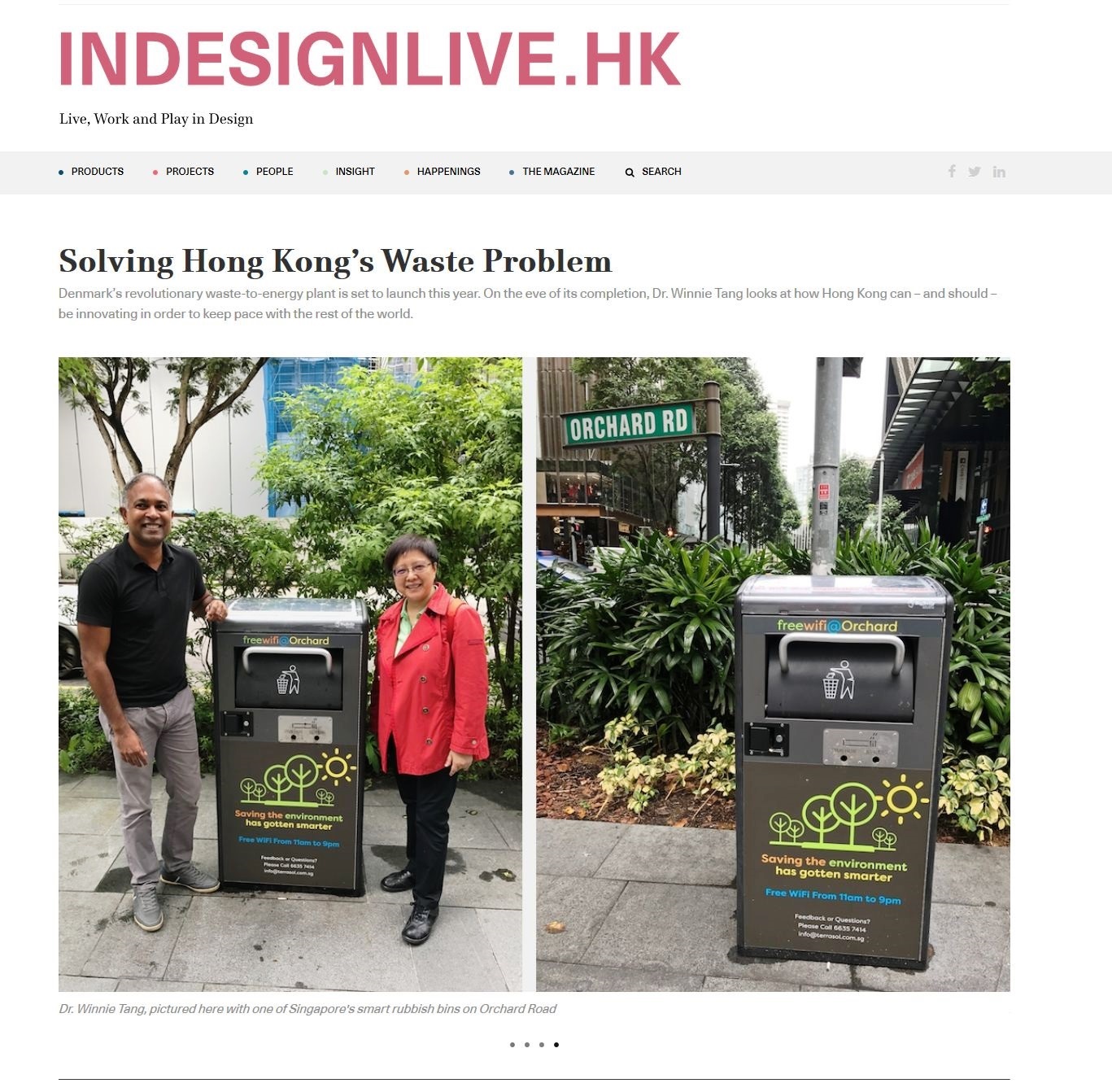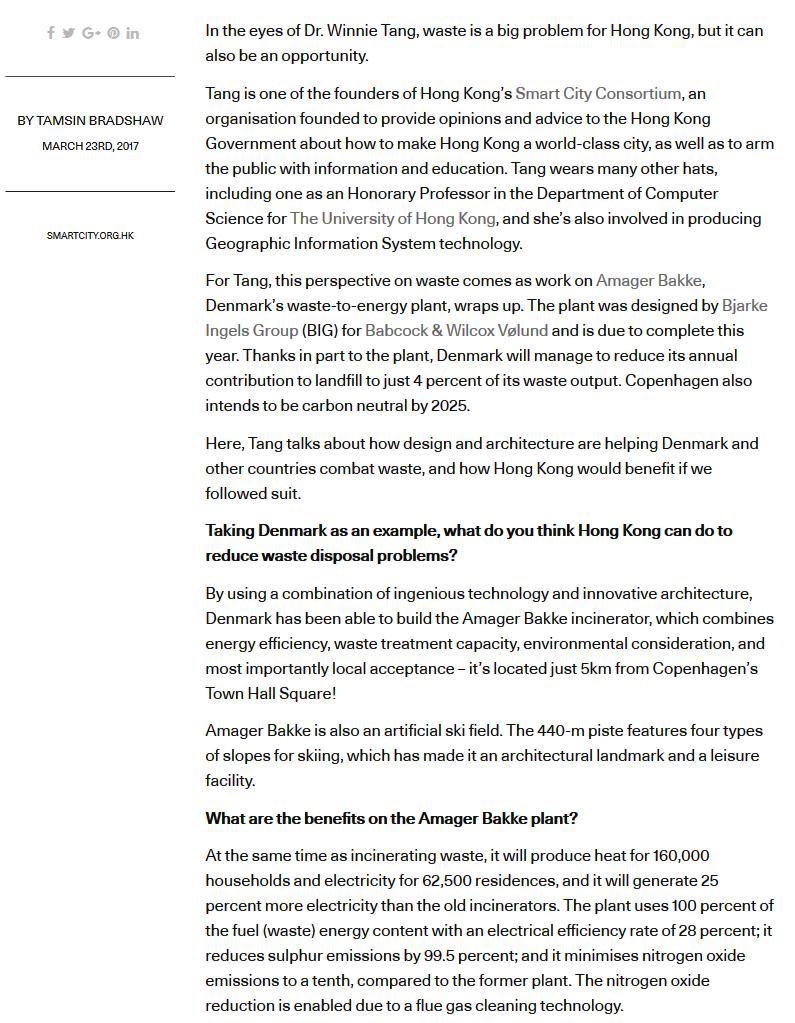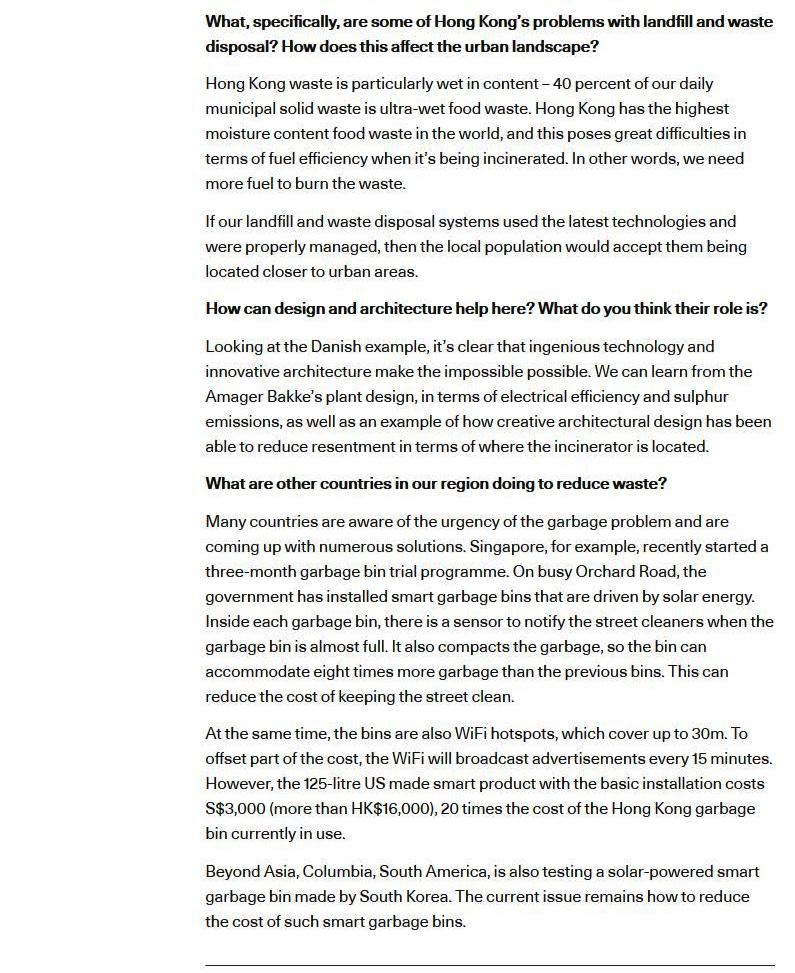網上版請按此



Solving Hong Kong's Waste Problem
Denmark's revolutionary waste-to-energy plant is set to launch this year. On the eve of its completion, Dr. Winnie Tang looks at how Hong Kong can – and should – be innovating in order to keep pace with the rest of the world.
In the eyes of Dr. Winnie Tang, waste is a big problem for Hong Kong, but it can also be an opportunity.
Tang is one of the founders of Hong Kong's Smart City Consortium, an organisation founded to provide opinions and advice to the Hong Kong Government about how to make Hong Kong a world-class city, as well as to arm the public with information and education. Tang wears many other hats, including one as an Honorary Professor in the Department of Computer Science for The University of Hong Kong, and she's also involved in producing Geographic Information System technology.
For Tang, this perspective on waste comes as work on Amager Bakke, Denmark's waste-to-energy plant, wraps up. The plant was designed by Bjarke Ingels Group (BIG) for Babcock & Wilcox Volund and is due to complete this year. Thanks in part to the plant, Denmark will manage to reduce its annual contribution to landfill to just 4 percent of its waste output. Copenhagen also intends to be carbon neutral by 2025.
Here, Tang talks about how design and architecture are helping Denmark and other countries combat waste, and how Hong Kong would benefit if we followed suit.
Taking Denmark as an example, what do you think Hong Kong can do to reduce waste disposal problems?
By using a combination of ingenious technology and innovative architecture, Denmark has been able to build the Amager Bakke incinerator, which combines energy efficiency, waste treatment capacity, environmental consideration, and most importantly local acceptance – it's located just 5km from Copenhagen's Town Hall Square!
Amager Bakke is also an artificial ski field. The 440-m piste features four types of slopes for skiing, which has made it an architectural landmark and a leisure facility.
What are the benefits on the Amager Bakke plant?
At the same time as incinerating waste, it will produce heat for 160,000 households and electricity for 62,500 residences, and it will generate 25 percent more electricity than the old incinerators. The plant uses 100 percent of the fuel (waste) energy content with an electrical efficiency rate of 28 percent; it reduces sulphur emissions by 99.5 percent; and it minimises nitrogen oxide emissions to a tenth, compared to the former plant. The nitrogen oxide reduction is enabled due to a flue gas cleaning technology.
What, specifically, are some of Hong Kong's problems with landfill and waste disposal? How does this affect the urban landscape?
Hong Kong waste is particularly wet in content – 40 percent of our daily municipal solid waste is ultra-wet food waste. Hong Kong has the highest moisture content food waste in the world, and this poses great difficulties in terms of fuel efficiency when it's being incinerated. In other words, we need more fuel to burn the waste.
If our landfill and waste disposal systems used the latest technologies and were properly managed, then the local population would accept them being located closer to urban areas.
How can design and architecture help here? What do you think their role is?
Looking at the Danish example, it's clear that ingenious technology and innovative architecture make the impossible possible. We can learn from the Amager Bakke's plant design, in terms of electrical efficiency and sulphur emissions, as well as an example of how creative architectural design has been able to reduce resentment in terms of where the incinerator is located.
What are other countries in our region doing to reduce waste?
Many countries are aware of the urgency of the garbage problem and are coming up with numerous solutions. Singapore, for example, recently started a three-month garbage bin trial programme. On busy Orchard Road, the government has installed smart garbage bins that are driven by solar energy. Inside each garbage bin, there is a sensor to notify the street cleaners when the garbage bin is almost full. It also compacts the garbage, so the bin can accommodate eight times more garbage than the previous bins. This can reduce the cost of keeping the street clean.
At the same time, the bins are also WiFi hotspots, which cover up to 30m. To offset part of the cost, the WiFi will broadcast advertisements every 15 minutes. However, the 125-litre US made smart product with the basic installation costs S$3,000 (more than HK$16,000), 20 times the cost of the Hong Kong garbage bin currently in use.
Beyond Asia, Columbia, South America, is also testing a solar-powered smart garbage bin made by South Korea. The current issue remains how to reduce the cost of such smart garbage bins.